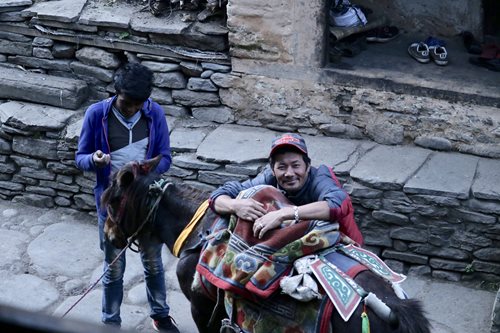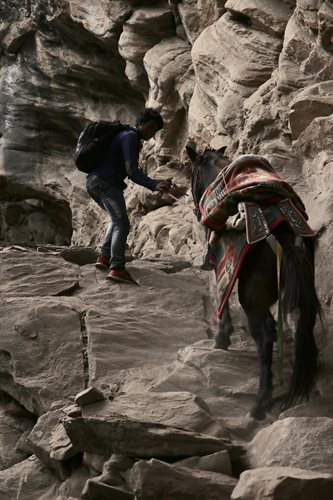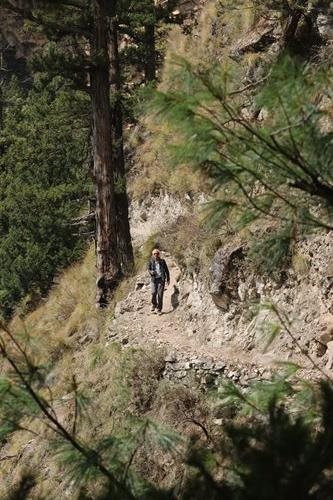During the first day of the trek, we’d ascended quite rapidly to the hamlet of Chekpa at 2720m in Dolpo and I wondered whether I might start to notice the altitude. The night was restful though and, sustained by Tibetan salt tea mixed with
tsampa (roasted barley flour), we continued on up the Suli Gad Khola. I was feeling trepidacious again. We were following the route of an epic journey by yak-herding nomads filmed by Eric Valley as
Himalaya and S helpfully mentioned that this stretch was where one of the yaks had fallen from the path and plunged to its death.
Treks in Nepal tend to trace river valleys or cross big ridges. It is wrong to assume that the valley walks will be the gentler of the two options. Valleys are so steep that paths tend to tack back and forward across flimsy bridges and often take high routes to avoid places where the valley is nothing but bare rock. Routes are lovely but will go close to the water only to climb steeply onto an alp, then descend again to the river. Paths may be boulder strewn too. The way to the small settlement of Ringmo – our first target – has been developed to encourage Nepalis to this beautiful part of the country so where the path is especially steep steps have been cut or rocks hewn to form staircases. These are great for humans but not so easy for ponies and mules.
Bishnu led little Gora at a steady modest walking pace but when we arrived at such steps he’d often stop, as if to say, ‘Really?’
By this second day I was getting a bit more confident of my ability to stay on Gora but still felt I needed some guidance from Bishnu – who demonstrated grabbing a big handful of mane in one hand, and the carpet on which I was perched with the other. Our guide Pemba also indicated where (using my third hand) I could hang on at the back of the saddle on the descents.
The downhills were especially difficult. Gora would pause at the top of a pile of big boulders, knowing his unshod hooves would slip, and consider how to get us down. Mostly he’d step down slowly but sometimes he’d jump both forefeet down together, or unexpectedly step sideways. I knew I needed to try to keep vertical with stirrups forward but then it feels like the pony is doing a gravity-defying hand-stand.
As Gora lurched up and down various sets of rock steps I clung on, marvelling at his ability to negotiate the terrain despite not really being able to see ahead of him and realised why the local ponies and mules are so heavily muscled about their shoulders.
I am nervous of heights and while I wanted to have complete confidence in Gora’s sure-footedness, I couldn’t convince myself he might not slip. The view below the path – sometimes the raging blue river was 300m beneath us – was amazing, glimpsed through huge junipers, blue pine, spruce and cypress but I tried not to look down. I found myself contemplating the best place to fall. My conclusion was it would be best to plunge from the highest point – then it would all be over quickly.
As the day progressed I found myself wanting to ride less and walk more until we reached the worse part of the route. At several points the high path was a sandy slot in the steep valley wall hardly the width of my two boots placed side by side. At one point, guide Pemba looked troubled and pointed to sand falling from above the path, and he said to me, ‘Go very quickly.’
He feared a landslip but we crossed safely and were back into forest. As the day was cooling we reached Chunuwar at 3134m where the salt tea tasted especially delicious.
The first part of this account is here
Pony trekking in Nepal and the next episode is here
October in Dolpo
 |
| Bishnu, Pemba and Gora |
 |
| Bisnu encouraging Gora to negotiate a rocky ascent |
 |
| S on the high level path - where we were up to 300m above the river |